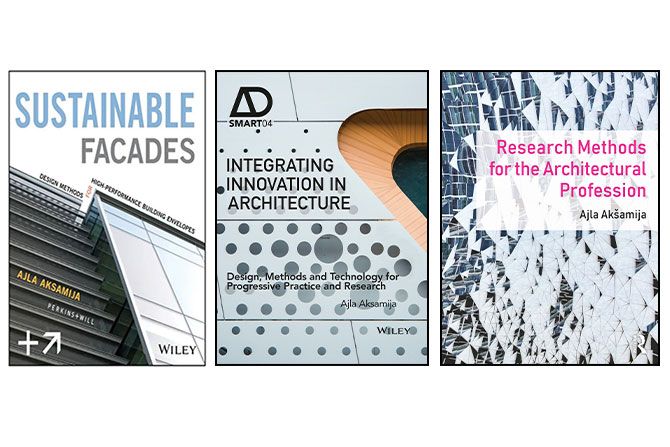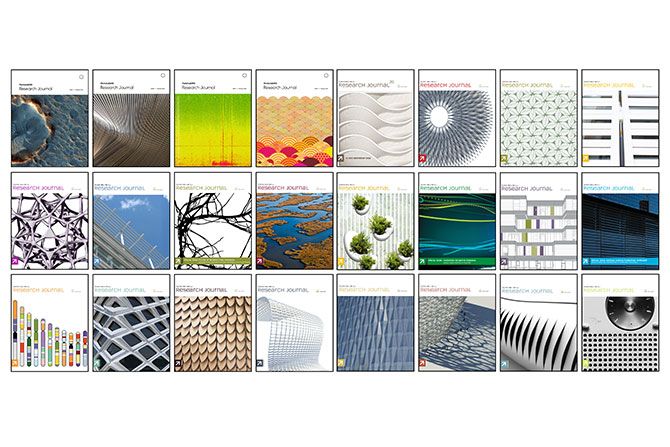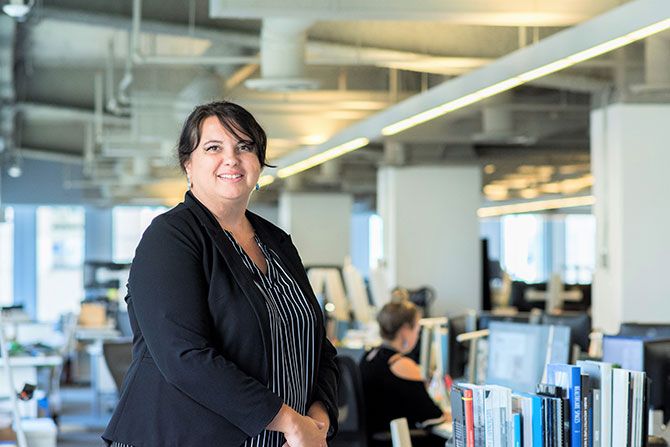Dr. Aksamija, Ph.D., LEED AP BD+C, CDT, FTI Fellow, a Professor at the University of Utah School of Architecture and author of three books about the craft, generously spent time with AIA Utah to discuss her life, profession and goals. Her expertise as an architect is renowned, and her varied projects are legendary.
We hope you enjoy this glance into the world of Dr. Ajla Aksamija.
What led you to architecture? Why did you choose to become an academic in this field?
I was interested in art and design from an early age. My passion for artistic expression and design began in elementary school – I had a wonderful art teacher who exposed us to drawing, art history, the history of the built environment and different architectural styles. But the older I got, I also gained an interest in science, math, and technical areas. I was always the nerdy kid who represented my schools at math and science competitions. When it came time to choose a major in college, I found architecture to be a perfect blend of art and science, where I would be able to utilize both sides of my brain.
When I started my professional career, I worked in the industry – not academia. As my professional career progressed, I realized I was interested in teaching and working with students. Therefore, I started teaching on a part-time basis and continued to do so for several years, besides holding a full-time job in the industry. At one point, I switched to a full-time academic job while continuing to work in the profession on a part-time basis. My academic career has been greatly influenced by my professional experiences.
What are your architectural specialties? Who are some of your favorite architects/buildings?
I specialize in building science, high-performance buildings, advanced building technologies, facade systems, computational design, and innovations in architecture. I am particularly passionate about integration of research and development within architectural practice.
In my professional career, I had an opportunity to work on the design of different building types, including healthcare facilities, K-12 schools, higher-education academic buildings, research labs, civic structures, and mixed-use buildings. Additionally I have written several books, Sustainable Facades: Design Methods for High-Performance Building Envelopes (2013); Integrating Innovation in Architecture: Design, Methods and Technology for Progressive Practice andResearch (2016) and Research Methods for the Architectural Profession (2021).
It is difficult to single out specific architects and buildings as my favorite, but I admire architects and firms that take into consideration contextual aspects (site and location, environmental factors, history, culture, occupants’ needs and comfort), utilize research-based design processes, and create context-sensitive and beautiful buildings that improve people’s lives.
What is your educational background (such as universities you have attended and degrees you have been awarded)? Please tell us a little about those experiences.
I am a proud alumna of the University of Illinois at Urbana-Champaign (UIUC), where I completed all my degrees. I obtained a Bachelor of Science in Architectural Studies degree with high honors, and then proceeded with the Master of Architecture program (design option). For my master’s thesis, I worked on sustainable, affordable housing and community development project. After completing the M.Arch degree and practicing for a while, I became interested in the research side of architecture. I realized I had more questions I wanted to answer and was trying to find ways to answer those questions. Therefore, I enrolled in a doctoral program and completed a Ph.D. in Architecture (technology and environment option). My doctoral work was very interdisciplinary, and I took many courses in engineering (civil and mechanical), computer science and material science. That experience was crucial for my future research work since I could look at architecture with a different lens and apply scientific principles to my research work. My dissertation research focused on the development of new computational tools (extension of Building Information Modeling) that can support design-decision making processes. I am very grateful to UIUC since its School of Architecture placed equal emphasis on design excellence, and technical and professional courses when I was a student.
Have you had important mentors during your career so far? Who were they, and what was the most important lesson you learned from them?
Interestingly, I never had a formal mentor during my career. Two individuals come to mind who profoundly impacted my career, but in a more informal way through collaborative projects and professional interactions. Things I learned from them shaped my perspectives and principles, most importantly relating to professional ethics, compassion and empathy, equity, and inclusion.
What three recommendations would you have for someone if you were mentoring them?
One, stay curious and never stop learning; two, be confident in your work but also humble, as actions speak more than words; and three, learn how to work collaboratively.
Tell us about your current position as a Professor at the School of Architecture.
I joined the University of Utah School of Architecture in 2021 and currently serve as a Professor and Chair. In my role as a professor, I teach courses, advise students, conduct research, and provide service to the University and profession. As the Chair of the School of Architecture, I provide administrative leadership for the school. This entails many different responsibilities, including strategic planning, faculty and staff management, curriculum oversight, student affairs, admissions and recruitment, financial administration, collaboration with the profession and local architectural community, and communications.
What are your goals for the School of Architecture?
My goals for the School of Architecture are to create an inclusive culture and educational environment that supports our students, faculty, and staff in executing our mission. We are committed to educating our students to be a transformative force that, through inclusive leadership, fundamentally changes our profession.
The primary goals for the School of Architecture are to:
- Foster a culture of innovation within our educational programs, research activities, community engagement and communication efforts
- Strengthen our educational programs and enrich students’ experiences
- Increase research opportunities for faculty and students, including interdisciplinary and transdisciplinary projects
- Improve collaborative efforts with the architectural industry, focusing on educational and research opportunities.
We developed a five-year Strategic Plan with specific actions that have been or will be undertaken to achieve these goals. We are already making great progress, evident in the highest number of applications for our graduate and undergraduate programs, faculty members’ recognition for research and creative practice, and students’ accomplishments.
Please explain the new programs and classes offered at the School of Architecture.
We have a lot of exciting developments at the School of Architecture. Several years ago, the School developed an integrated curriculum model for our undergraduate and accredited graduate programs. This means that our architectural design studios are integrated with other classes (design communications, history and theory, research methods, building technology), where students apply knowledge obtained in different courses to their design studio projects. This is quite innovative and reflects the architectural profession. This approach to architectural education also requires close collaboration and coordination among faculty members that teach various classes. Last year, we developed and implemented an assessment plan for the analysis and continuous improvement of our educational programs. We are already seeing the benefits of this plan since we are evaluating teaching objectives, methods, and students’ outcomes and adjusting our curriculum accordingly.
We have a new website, social media channels, and regular newsletters sent to our students, faculty and staff, alumni, and professional community. This has improved our communication and engagement efforts.
The American Institute of Architecture Students (AIAS) University of Utah chapter is a student-run organization that was re-launched last year after several years of inactivity. I am very grateful to our students for recognizing that leadership and collaborative opportunities, such as involvement with the AIAS, are crucial for their educational experiences.
We revamped our post-professional, research-based Master of Science in Architectural Studies program. Students in this program work on relevant research projects that can benefit the architectural industry and expand our knowledge. Our admissions process for the undergraduate Bachelor of Science in Architectural Studies has been revised to be more inclusive and allow students to begin the architecture major earlier than before.
Our DesignBuildUTAH program engages graduate students in design and construction projects, where students apply foundational knowledge obtained in the classroom to real-world projects through the DesignBuildUTAH@Bluff and DesignUTAH@SLC programs. We have newly appointed Co-Directors of the DesignBuildUTAH and Directors of Undergraduate and Graduate Studies.
New classes our School offers include design computation and communication electives, as well as electives on building technology. We improved our professional integration sequence for our graduate students.
Our lecture series is now offered in a hybrid format to allow professionals to participate and obtain continuing education credits. The Spring 2022 Lecture Series theme was “Diversity, Equity, and Inclusion in Architecture,” and for Spring 2022, “Architecture & Environmental Justice in a Post-Pandemic World.” For Spring 2023, our theme will be “The Housing Question: Affordability, Amenities, Alternatives.”
I am particularly excited to share that we are initiating a new research entity at our School—Transforming Places, Practices and Pedagogies Collaborative (TP3C). The mission of TP3C is to develop new knowledge, spur innovation, engage in cutting-edge research that addresses current challenges in architecture, bridge the gap between the architectural profession and academia, and engage in collaborative research projects.
What Degree programs are offered?
We offer an undergraduate, pre-professional Bachelor of Science in Architectural Studies (BSAS), as well as two graduate programs. The first is a professional, NAAB-accredited Master of Architecture (M.Arch) program, and the second is a post-professional, research-based Master of Science in Architectural Studies (MSAS) program. Our Master of Architecture has two paths, depending on the previous academic background and undergraduate degrees that our applicants have completed. Our two-year M.Arch program is suitable for graduate students with an undergraduate degree in architecture, while our 3+ M.Arch program is for students who have completed their undergraduate studies in other fields. The 3+ M.Arch program consists of seven semesters or three and a half years.
We also offer a dual M.Arch/MSAS program.
What certifications are offered?
The graduate certificate in Urban Design is offered jointly by the School of Architecture and the Department of City & Metropolitan Planning.
Do you have any last words that summarize your thoughts for anyone reading your article?
I’ve lived in Salt Lake City for a year and a half. During that time, I had an opportunity to meet with many local and regional architectural professionals and professionals from related disciplines (engineering, construction, and urban design). I also had an opportunity to meet with many of our alums. The legacy of the School of Architecture, its rich history, and connection to our alums are simply amazing. I am deeply grateful to the local and regional professionals for making me feel so welcome, and I look forward to many more years of collaboration.


Perkins&Will Research Journal covers. Ajla Aksamija is the founder of this first, open access peer-reviewed research journal coming from the architectural profession and served as the editor for 14 years.






